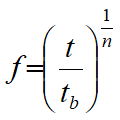*Fatigue Data
To assign fatigue data to hot spot sets.
Refer to Fatigue Analysis (Mode 1) for further information on this feature.
A block of two lines to specify the fatigue data for each hot spot set. The first line defines the name of the hot spot set to which the fatigue data will be assigned. The second line specifies the fatigue data for the hot spots in the set in the following format.
SET=Hot Spot Set Name
CURVE=S-N Curve Name [, SCF=SCF Value] [, STRESS=Stress
Type] [, TB=Threshold Thickness] [, EXPONENT=Exponent Value]
Hot Spot Set Name must be defined using *HOT SPOT SETS. S-N Curve Name must be defined using *S-N CURVE. SCF Value defaults to 1.0. Stress Type can be COMBINED (the default), BENDING or AXIAL. If a Threshold Thickness is not specified, thickness effects are not included in the fatigue-life calculations. The specification of an Exponent Value is meaningful only if thickness effects are included. Exponent Value defaults to 4.
Input: |
Description |
Set Name: |
The hot spot set to which the fatigue properties are to be assigned. |
S-N Curve: |
The name of a defined S-N curve. |
SCF: |
The stress concentration factor (SCF) to be used in fatigue calculations. |
Stress Type: |
This option allows you to nominate the type of stress to be used in the fatigue calculations. You can choose between bending stresses only, axial stresses only or combined bending and axial stresses, which is the default. |
Threshold Thickness: |
The threshold thickness for the inclusion of thickness effects. See Notes (a) and (b). |
Exponent: |
The exponent value n used in the calculation of the stress multiplication factor when threshold thickness effects are included. This defaults to 4. See Notes (a) and (b). |
(a)The specification of a threshold thickness allows you to take account of the fact that the fatigue strength of some structural members can be dependent on material thickness, fatigue strength decreasing with increasing thickness. If you specify a threshold thickness, the stresses calculated by LifeTime are further multiplied by a factor ![]() given by:
given by:

where ![]() is the specified threshold thickness; and
is the specified threshold thickness; and ![]() is the greater of
is the greater of ![]() and the actual thickness of the particular location under consideration (this ensures that is always greater than or equal to 1). Note that although a single value of
and the actual thickness of the particular location under consideration (this ensures that is always greater than or equal to 1). Note that although a single value of ![]() is input,
is input, ![]() is naturally computed individually for each hot spot, since the structure thickness may vary from location to location. The exponent value n can also be specified and defaults to 4.
is naturally computed individually for each hot spot, since the structure thickness may vary from location to location. The exponent value n can also be specified and defaults to 4.
(b)The specification of threshold thickness is optional. By default, thickness effects are ignored unless you explicitly specify a threshold thickness.